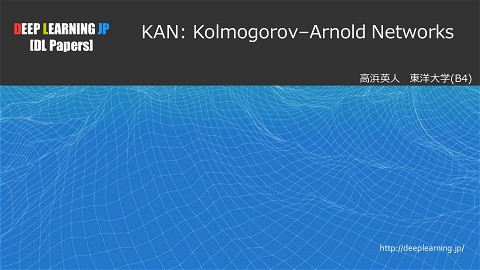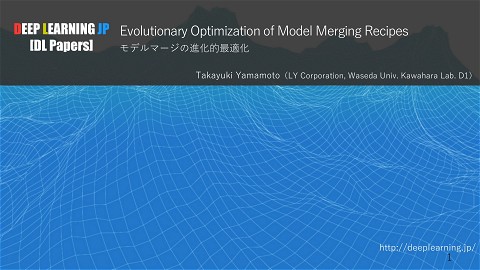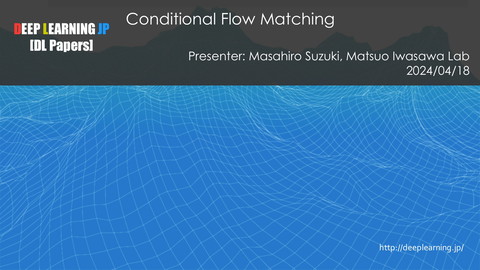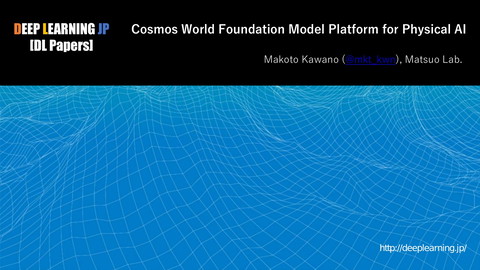[DL輪読会]A closer look at few shot classification
121 Views
March 04, 19
スライド概要
2019/03/01
Deep Learning JP:
http://deeplearning.jp/seminar-2/
DL輪読会資料
関連スライド
各ページのテキスト
DEEP LEARNING JP [DL Papers] A Closer Look at Few-shot Classification (ICLR2019) Kazuki Fujikawa, DeNA http://deeplearning.jp/ 1
サマリ • 書誌情報 – A Closer Look at Few-shot Classification • ICLR2019(to appear) • Wei-Yu Chen, Yen-Cheng Liu, Zsolt Kira, Yu-Chiang Frank Wang, Jia-Bin Huang • 概要 – Few-shot classificationの標準的な評価方法の問題を指摘 • Few-shot learningで標準的に用いられる実験設定において、今回定義するBaseline++は SOTAに匹敵する • 大きなNNを用いた場合、CUB, mini-ImageNet両方のベンチマークデータセットで BaselineがSOTAに匹敵する • データにドメインシフトがある場合、Baselineの方が優れている – 適切に比較可能な実験設定で一貫して実験できるよう、実験コードを公開 • まだ解かれていないドメインシフトのあるFew-shot Learningの問題が前進することを期待する 2
アウトライン • 背景 • 比較手法 • 実験・結果 3
アウトライン • 背景 • 比較手法 • 実験・結果 4
背景 • Few-shot classification を扱う研究が近年増加している – 解きたいタスクの教師データが少ない場合に、大規模データから他のタスクでも転用可能 な知識を抽出できるようにしよう、というのが一つの方向性 Meta Learning Models Taxonomy Model Based ● ● ● ● ● Santoro et al. ’16 Duan et al. ’17 Wang et al. ‘17 Munkhdalai & Yu ‘17 Mishra et al. ‘17 Metric Based ● ● ● ● ● Koch ’15 Vinyals et al. ‘16 Snell et al. ‘17 Shyam et al. ‘17 Sung et al. ‘17 Optimization Based ● ● ● ● ● ● ● Schmidhuber ’87, ’92 Bengio et al. ’90, ‘92 Hochreiter et al. ’01 Li & Malik ‘16 Andrychowicz et al. ’16 Ravi & Larochelle ‘17 Finn et al. ‘17 Ada ptedf r om Fi nn ‘ 1 7 図引用: Vinyals, Oriol. NIPS 2017 Meta-Learning symposium. Or i olVi ny a l s, NI PS 1 7 • 一方過去の研究では下記の観点で課題がある – ベースラインのパフォーマンスが不当に低評価されており、公平な評価ができていない • Data augumentationされていない、等 – データのドメインシフトを考慮していない • 未知のクラスも同じデータセットからサンプリングして評価している 5
アウトライン • 背景 • 比較手法 • 実験・結果 6
Baseline • 問題設定 – Training stage • Base classのデータを使って特徴抽出器 𝑓𝜃 , 分類器 𝐶(∙ |𝐖𝑏 ) を学習する • Base class: Few-shotで分類したいクラスとは別のクラスのデータ (ラベル付きデータが大量にある前提) – Fine-tuning stage • 𝑓𝜃 は固定し、Novel classのデータを使って分類器 𝐶(∙ |𝐖𝑛 ) を学習する Published as a conference paper at ICLR 2019 • Novel class: Few-shotで分類したいクラスのデータ (ラベル付きデータが数件しか無い前提) Training stage Base class data (Many) Feature extractor Fine-tuning stage Classifier Novel class data (Few) Fixed Feature extractor Classifier Classifier Cosine distance … Softmax ! Baseline++ … Linear layer Softmax ! Baseline Figure 1: Baseline and Baseline++ few-shot classification methods. Both the baseline and 7
Baseline • モデル – Baseline • 𝑓𝜃 (𝐱 𝑖 ) と 𝐖 ∈ ℝ𝑑×𝑐 との内積に基づくクロスエントロピー誤差を最小化する – Baseline++ • 𝑓𝜃 (𝐱 𝑖 ) と 𝐖𝑏 = 𝐖1, 𝐖2 , … , 𝐖𝑐 ∈ ℝ𝑑×𝑐 とのコサイン距離に基づくクロスエントロピー誤差を 最小化する • Baselineと比べてクラス内変動(intra-class variation)を減らすことが狙い Published as a conference paper at ICLR 2019 • [Hu+, CVPR2015], [Gidaris & Komodakis, CVPR2018] でも導入されている Training stage Base class data (Many) Feature extractor Fine-tuning stage Classifier Novel class data (Few) Fixed Feature extractor Classifier Classifier Cosine distance … Softmax ! Baseline++ … Linear layer Softmax ! Baseline Figure 1: Baseline and Baseline++ few-shot classification methods. Both the baseline and 8
Few-shot classification • 問題設定(N-way K-shot) – Meta-testing stage • Support set(N件ずつのKクラスラベル付きデータ)を手がかりに、Query set(ラベル無し データ)をKクラスいずれかに分類する – Meta-training stage • Meta-testingでの状況に合わせて、Support set, Query setをBase classからサンプリングする • サンプリングされたQuery setが、Support setを参考に正しく分類できるように特徴抽出器 𝑓𝜃 を Published as a conference paper at ICLR 2019 学習する Meta-testing stage Meta-training stage Sampled # classes Base support set !" Base class data (Many) Base query set MatchingNet Euclidean distance Relation Module MAML Linear distance Support set conditioned model RelationNet ProtoNet Class Class mean $ mean $ ) Linear Feature extractor Cosine Novel support set (Novel class data Support set conditioned model Gradient Figure 2: M eta-lear ning few-shot classification algor ithms. The meta-learning classifier M(·|S) is conditioned on the support set S. (Top) In the meta-train stage, the support set Sb and the query 9
Few-shot classification • モデル – MatchingNet [Vinyals+, NIPS2016] • Nクラス x Kサンプルの Support set と Query set に対してそれぞれ 𝑓𝜃 で特徴抽出 • コサイン距離に基づくクロスエントロピー誤差を最小化 – ProtoNet [Snell+, NIPS2017] • Nクラス x Kサンプルの Support set と Query set に対してそれぞれ 𝑓𝜃 で特徴抽出 Published as a conference paper at ICLR 2019 • Support set から得られた特徴ベクトルをクラス毎に平均し、N個のprototype(ベクトル)を作る • Query set のベクトルとprototypeとのユークリッド距離に基づくクロスエントロピー誤差を最小化 Meta-testing stage Meta-training stage Sampled # classes Base support set !" Base class data (Many) Base query set MatchingNet Euclidean distance Relation Module MAML Linear distance Support set conditioned model RelationNet ProtoNet Class Class mean $ mean $ ) Linear Feature extractor Cosine Novel support set (Novel class data Support set conditioned model Gradient Figure 2: M eta-lear ning few-shot classification algor ithms. The meta-learning classifier M(·|S) is conditioned on the support set S. (Top) In the meta-train stage, the support set Sb and the query 10
Few-shot classification • モデル – RelationNet [Sung+, CVPR2018] • 大枠はProtoNetと同じ • NNでパラメタライズされたRelation Moduleのスコアに基づくクロスエントロピー誤差を最小化 – MAML [Finn+, ICML2017] • Support set(小数のラベル付きデータ)でFine-tuningをした時に、Query setの予測誤差が 小さくなるようなモデルパラメータの初期値を学習する Published as a conference paper at ICLR 2019 Meta-testing stage Meta-training stage Sampled # classes Base support set !" Base class data (Many) Base query set MatchingNet Euclidean distance Relation Module MAML Linear distance Support set conditioned model RelationNet ProtoNet Class Class mean $ mean $ ) Linear Feature extractor Cosine Novel support set (Novel class data Support set conditioned model Gradient Figure 2: M eta-lear ning few-shot classification algor ithms. The meta-learning classifier M(·|S) is conditioned on the support set S. (Top) In the meta-train stage, the support set Sb and the query 11
アウトライン • 背景 • 関連研究 • 比較手法 • 実験・結果 12
データセット • mini-ImageNet – ImageNetをベースに、計算量削減のため解像度 やクラス数を限定して作成したデータセット • 解像度: 84x84 • データ数(計60,000件) – train: 64クラス x 600件 – valid: 16クラス x 600件 – test: 20クラス x 600件 • CUB Russakovsky, Olga, et al. "Imagenet large scale visual recognition challenge." International journal of computer vision 115.3 (2015): 211-252. – 鳥に関する粒度の細かいラベルがつけられた 画像のデータセット • データ数(計11,788件) – train: 100クラス – valid: 50クラス – test: 50クラス Wah C., Branson S., Welinder P., Perona P., Belongie S. “The Caltech-UCSD Birds-200-2011 Dataset.” Computation & Neural Systems Technical Report, CNS-TR-2011-001. 13
実験概要 • タスク概要 – 実験1: 論文の報告に多い標準の問題設定で、各手法を統一的に再評価 – 実験2: 特徴抽出器のNNを深くしたモデルを使って各手法を実験 – 実験3: ドメインシフトがある設定(mini-ImageNet→CUB)で各手法を実験 • ハイパーパラメータ – 手法特有のハイパーパラメータは下記のように設定 • baseline, baseline++ – training stage: batchsize: 16, epochs: 400 – testing stage: batchsize: 4, iterations: 100 • meta-learning – 1-shot: 60,000 episodes, 5-shot: 40,000 episodes 14
実験1: 標準設定による再評価 • 各比較手法について、実験設定を標準設定で揃えて再実験 – データセット: mini-ImageNet, 特徴抽出器 𝑓𝜃 : 4層CNN – 各手法の設定 • Baseline ⇔ Baseline*: data-augmentation有り ⇔ 無し • ProtoNet ⇔ ProtoNet#: 5-way ⇔ 30-way(1-shot), 20-way(5-shot) でmeta-train • 考察 – Baselineについては、data-augmentationすることにより改善可能であり、報告値は 過小評価されている – Baseline++を含めて比較するとSOTA手法に匹敵する 15
実験2: 特徴抽出器のNNを深化させた実験 • 各比較手法について、特徴抽出器のNNを深化させた時のパフォーマンスを比較 – データセット: CUB, mini-ImageNet – 特徴抽出器 𝑓𝜃 : 4層CNN, 6層CNN, ResNet-10, ResNet-18, ResNet-34 • 考察 – CUBでは層の深さを深くした場合に手法間の差が小さくなっている – mini-ImageNetでは層を深くするとBaselineに負ける手法が出てくる 16
実験3: ドメインシフトを含む実験 • 各比較手法について、ドメインシフトを含む場合のパフォーマンスを比較 – データセット: mini-ImageNet (meta-training) → CUB (meta-testing) – 特徴抽出器 𝑓𝜃 : ResNet-18 • 考察 – BaselineがMeta-learningの手法全てを上回る結果に Published as a conference paper at ICLR 2019 – ドメイン間の相違が増大するにつれ、Meta-learningの手法は相対的に有効でなくなる という結果になった Baseline Baseline++ MatchingNet ProtoNet MAML RelationNet 90% mini-I mageNet ! CUB 80% Baseline Baseline++ 65.57± 0.70 62.04± 0.76 70% M atchingNet ProtoNet M AM L RelationNet 53.07± 0.74 62.02± 0.70 51.34± 0.72 57.71± 0.73 50% Table 3: 5-shot accur acy under the cross-domain scenar io with a ResNet-18 backbone. Baseline outperforms all other 60% 40% CUB miniImageNet Small miniImageNet -> CUB Large Domain Difference Figure 4: 5-shot accur acy in differ ent scenar ios with a ResNet-18 backbone. The Baseline model performs relative well with larger domain 17
結論 • Few-shot classificationの標準的な評価方法の問題を指摘 – Few-shot learningで標準的に用いられる実験設定において、Baseline++はSOTAに匹敵 – 大きなNNを用いた場合、CUB, mini-ImageNet両方のベンチマークデータセットで BaselineがSOTAに匹敵 – データにドメインシフトがある場合、Baselineの方が優れている • 適切に比較可能な実験設定で一貫して実験できるよう、実験コードを公開 – まだ解かれていないドメインシフトのあるFew-shot Learningの問題が前進することを期待 18
References • Wei-Yu Chen, Yen-Cheng Liu, Zsolt Kira, Yu-Chiang Frank Wang, Jia-Bin Huang. A Closer Look at Few-shot Classification. In ICLR 2019. • Spyros Gidaris and Nikos Komodakis. Dynamic few-shot visual learning without forgetting. In CVPR 2018. • Junlin Hu, Jiwen Lu, and Yap-Peng Tan. Deep transfer metric learning. In CVPR 2015. • Oriol Vinyals, Charles Blundell, Tim Lillicrap, Daan Wierstra, et al. Matching networks for one shot learning. In NIPS 2016 • Jake Snell, Kevin Swersky, and Richard Zemel. Prototypical networks for few-shot learning. In NIPS 2017. • Flood Sung, Yongxin Yang, Li Zhang, Tao Xiang, Philip HS Torr, and Timothy M Hospedales. Learning to compare: Relation network for few-shot learning. In CVPR 2018. • Chelsea Finn, Pieter Abbeel, and Sergey Levine. Model-agnostic meta-learning for fast adaptation of deep networks. In ICML 2017. 19







